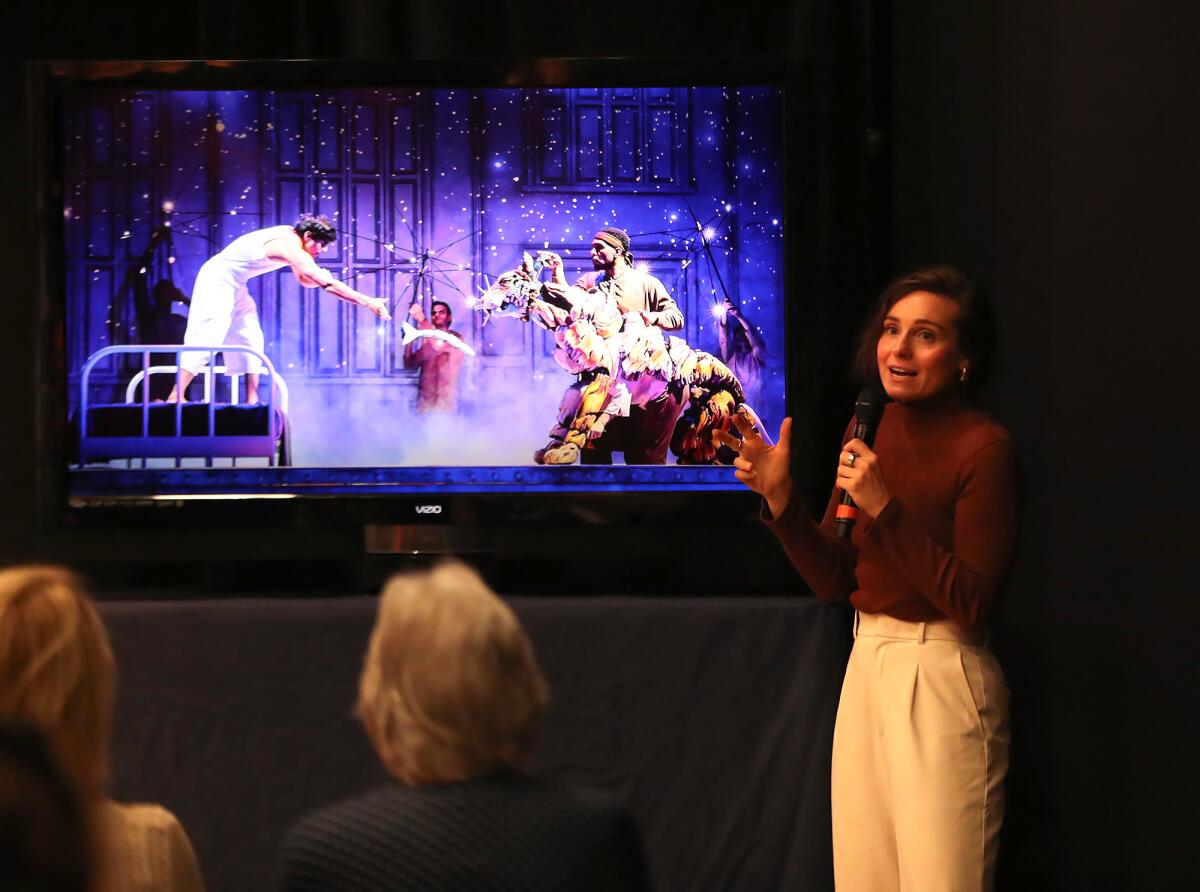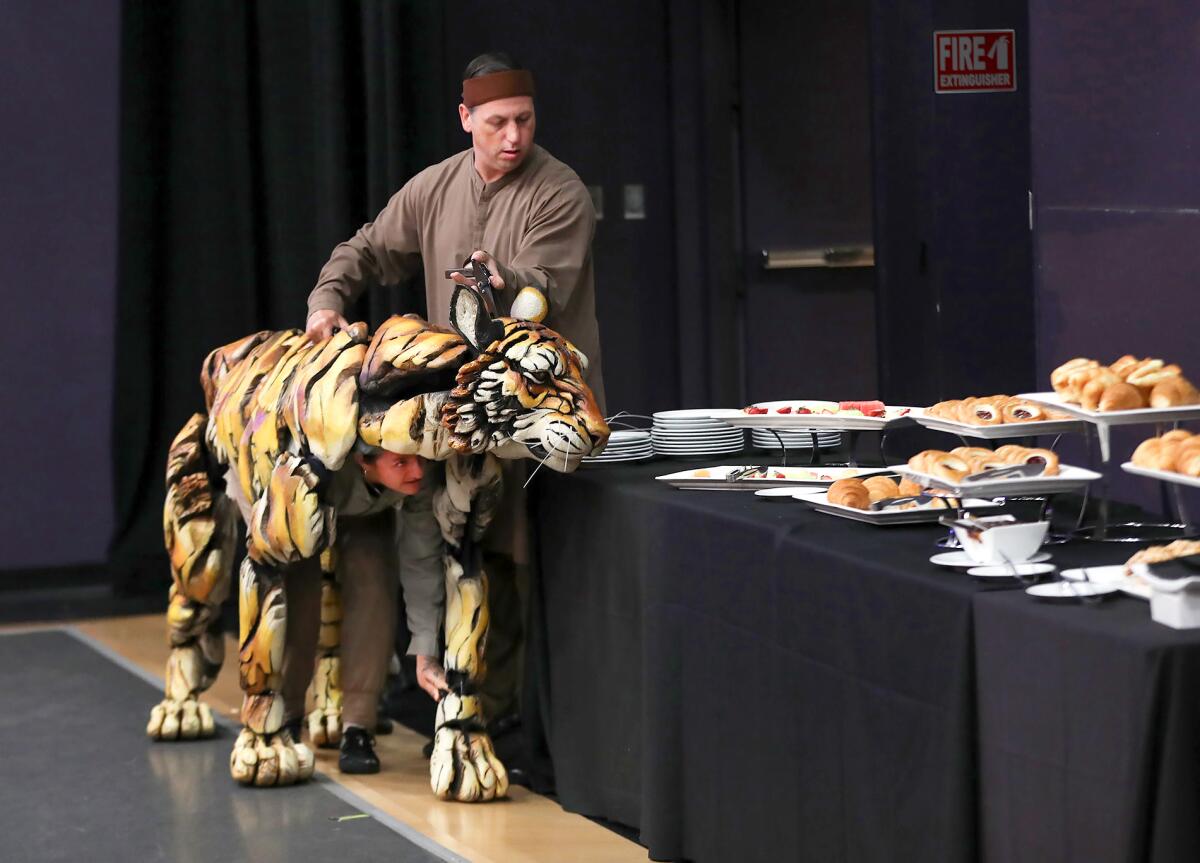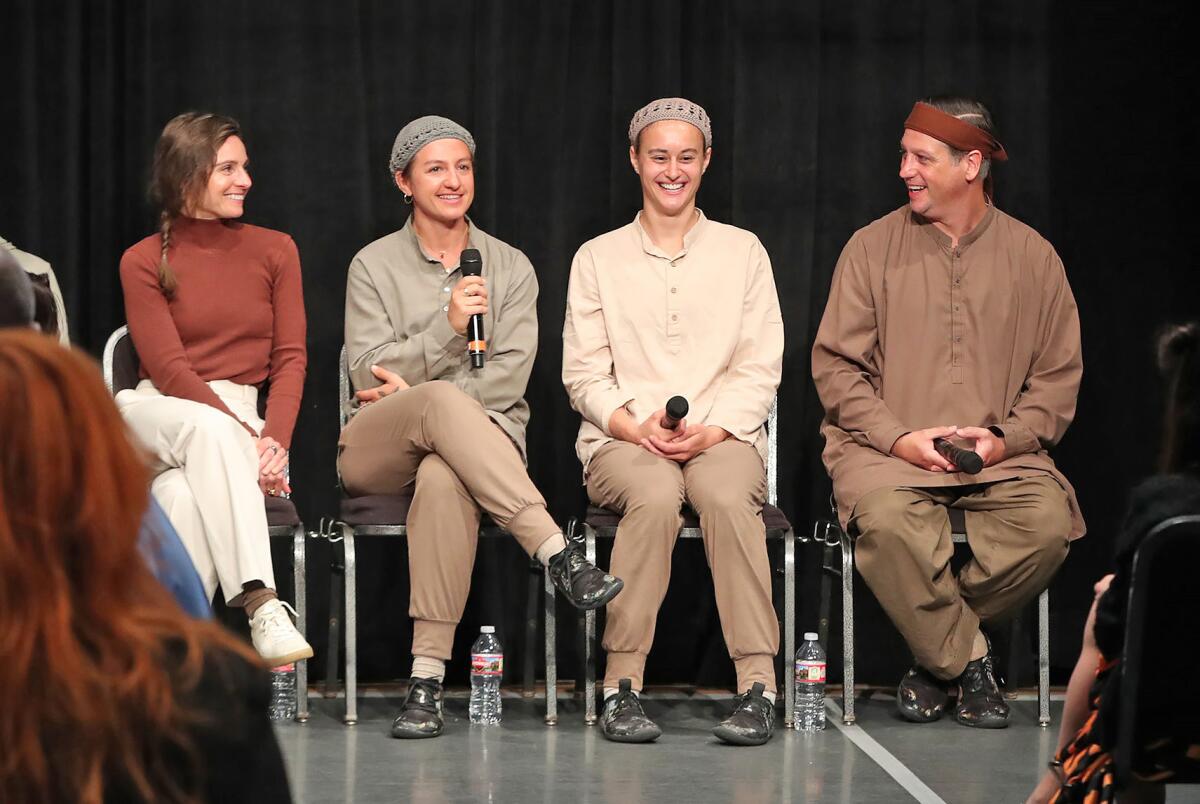‘Life of Pi’ roars to life at Segerstrom

- Share via
When Richard Parker slinks into the room, it is difficult not to catch your breath. The Royal Bengal tiger puppet is the star of the stage production of “Life of Pi” and the puppeteers who operate him — Aaron Haskell, Anna Vomacka and Anna Leigh Gortner — have mastered the feline form. They move the 35-pound puppet with realistic movements and sounds that mimic a real tiger, making you wonder how safe you are when he breathes into your lap.
“We really try not to Disney-fy the animals,” said Taha Mandviwala, who plays the role of Pi in the production. “We want to give them the physics that animals have, that sense of ferocity, that sense of weight, the sense that this thing has the capacity to kill at any moment.”
On stage at Segerstrom Center for the Arts in Costa Mesa now through June 15, “Life of Pi” is based on the 2001 novel by Yann Martel of the same name, adapted for the stage by Lolita Chakrabarti. The story follows 16-year-old Pi, who gets shipwrecked in the middle of the Pacific Ocean when the boat carrying his family and the animals in their zoo from India to Canada sinks. Stuck on a lifeboat for 227 days, he is joined by a hyena, a zebra, an orangutan and a tiger named Richard Parker.

The animals play key roles in the storytelling and, in addition to Richard Parker, the touring cast and creative team bring an entire zoo to life using the captivating puppets. The day after opening night, Segerstrom hosted a demonstration of the tiger puppet at the Judy Morr Theater, where the famous feline purred and chuffed at a nervous crowd.
Movement director and puppeteer Betsy Rosen and John Hoche, associate puppetry and movement director for “Life of Pi” U.S., joined Haskell, Vomacka and Gortner for the demo along with Mandviwala. The production is a decorated one, with three Tony awards, the Olivier Award for Best Play and the 2022 Best Supporting Actor award for a group of puppeteers’ portrayal of Richard Parker.
“That means not only was a tiger nominated for an award, but a puppet was also nominated for this award and the team of puppeteers that brought Richard Parker to life were all nominated,” said Hoche. “The incredible thing is [that] they won, so that is a huge step forward for understanding and appreciating the art form of puppetry.”

Operating the tiger puppet is a task that requires skill and finesse from three players, who each operate the head, the heart and hindquarters of the animal. Haskell, Vomacka and Gortner operate the tiger during about three of the eight weekly shows, since the role is quite physically demanding. The head puppeteer operates the head and cage of the animal, or the ribs, via a handle on the spine.
“Their primary objective is to keep the head active; there are ear triggers and a jaw trigger there,” said Rosen.
The heart puppeteer manipulates the front paws of the tiger and creates breath within the tiger while the hind puppeteer operates the back paws and tail, maintaining the gait and walk of the tiger and using the tail to express emotion.
“I find a lot of personality in the tail,” said Gortner. “Just like any animal, when Richard Parker is scared, his tail will tuck. If he is feeling aggressive or angry, it will lift. If he is hungry, it might wag a bit.”
Sounds the tiger makes also signal emotion.
“All three puppeteers are mic’d live which means we are making all of the sounds live, and that goes for all of the puppets in the show,” said Rosen.

Mandviwala said acting with a puppet has two sides to it.
“One side is very technical and one side is artistic. On an artistic level, you are acting alongside a puppet, you really need to treat it completely in the same way you would treat working with another actor,” said Mandviwala. “On a technical level of acting with it, you also have to keep a lookout for your fellow coworkers, the puppeteers in the boat.”
While Mandviwala and the other actors are very aware of the puppeteers, the audience is less so, especially as the story goes on. It seems we notice them less and less as our imaginations take us through the story. The amount of emotion Haskell, Vomacka and Gortner evoke from the audience with a puppet is incredible. As a viewer, you are aware you are not really seeing a goat get eaten by a tiger for example, yet the crowd gasps and grimaces as if they are.

“A teacher told me once that the audience, just like you, came here with your imagination open,” said Haskell. “You wanted to see something good and see something come to life and so a lot of that is on us to make sure you stay in that imagination. You want to believe, we allow you to believe and we make you continue to believe.”
Rosen said the team achieves this partly by hiding in plain sight.
“We are not trying to disappear completely, we are not dressed in all black,” said Rosen. “I think there is this mentality and physicality of serving this greater overall character, that we are all doing at the same time and we recede into the background, in service of bringing this other character to life.”
Haskell said the three puppeteers all pay attention to each other, while also all jointly focusing on the tiger’s view point, which helps them become the puppet.
“One of the major ways we do that is our focus into the puppet. We use a lot of our peripheral vision because we want you to see our focus is on the head, which psychologically somehow really does make the audience also go there with you,” said Haskell.
Vomacka and Gortner both said maintaining healthy habits and exercise routines, like yoga and gymnastics, help them keep up with the physically demanding work of crouching inside the puppet for a two-hour show.

“Humans are incredible,” said Vomacka. “You put a challenge in front of us, we train for it and we acclimate.”
Hoche said that while the show’s puppeteers demonstrate great skill and talent, their passion is one born from storytelling play, something everyone in the audience can relate to.
“Everyone at some point in your life has played with a doll or played with an action figure or made a stick come to life,” said Hoche. “Everyone is a puppeteer.”
“Life of Pi” is showing now at Segerstrom Center for the Arts at 600 Town Center Dr, Costa Mesa through June 15. Tickets, which start at $44.07, are available at scfta.org.
All the latest on Orange County from Orange County.
Get our free TimesOC newsletter.
You may occasionally receive promotional content from the Daily Pilot.



